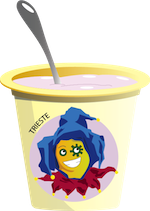Team:Trieste/project/modeling
From 2012.igem.org
Modeling
More
Assumptions
- No interaction with living tissue
Model description
We chose to use a deterministic, empirical model because it gives simple, clean solutions.
The model is composed of 6 differential equations, each one describing the concentration of a substance inside or outside the bacteria.
All the \(\delta_i\) parameters represent the variable's decay over time.
The first equation, describing the bacteria concentration in the media (bacteria growth) is based on the logistics function: \begin{equation} \dot{x} = x (1-x) \end{equation} We added a term to model bacteria death due to toxin, so the complete equation is: \begin{equation} \dot{b} = k_1 b (N - b) - k_2 b (l_i + l_e) \end{equation} There are three parameters that control this model's behaviour. The \(N\) parameter specifies the maximum concentration of bacteria. The \(k_1\) parameter controls the growth speed and the \(k_2\) parameter sets how powerful the toxin is.
The next equation models the CymR concentration inside the bacteria. \begin{equation} \dot{p} = k_3 - \delta_1 p - \alpha p c \end{equation} The \(k_3\) parameter determines the rate of synthesis of CymR and \(\alpha\) the rate of cumate ligation.
The p-cumate concentration function is in fact a parameter, because it is directly controllable by adding p-cumate into the bacteria solution. \begin{equation} \dot{c} = k_4 - \delta_2 c \end{equation} The \(k_4\) parameter models p-cumate increase (adding p-cumate at a steady rate).
We use two equations to better model the toxin concentration, taking into account the concentration of toxin both inside and outside the bacteria. The equation for the inside concentration is a Hill equation with a decay term. We used it because the concentration increases until the saturation is reached, and from then on the bacteria stops producing the toxin. The point of saturation is never reached, though, because the bacteria dies due to the toxin itself. The outside equation is the most complex one; the outside toxin concentration depends on bacteria death: when the bacteria dies, all the toxin it has produced is released outside. \begin{align} \dot{l_i} &= \frac{A}{k_5 + p} -\delta_3 l_i \\ \dot{l_e} &= v (l_i + l_e) b l_i - \delta_4 l_e \end{align} The \(A\) parameter sets the maximum toxin concentration inside the bacteria, while the \(v\) parameter takes into account the toxin dilution in the bacteria solution.
Last but not least, the antibody density, which we suppose always increasing in time. \begin{equation} \dot{a} = k_6 - \delta_5 a \end{equation}
Tools
We decided to use Octave, the open source alternative to Matlab as the framework for our model.









 "
"









